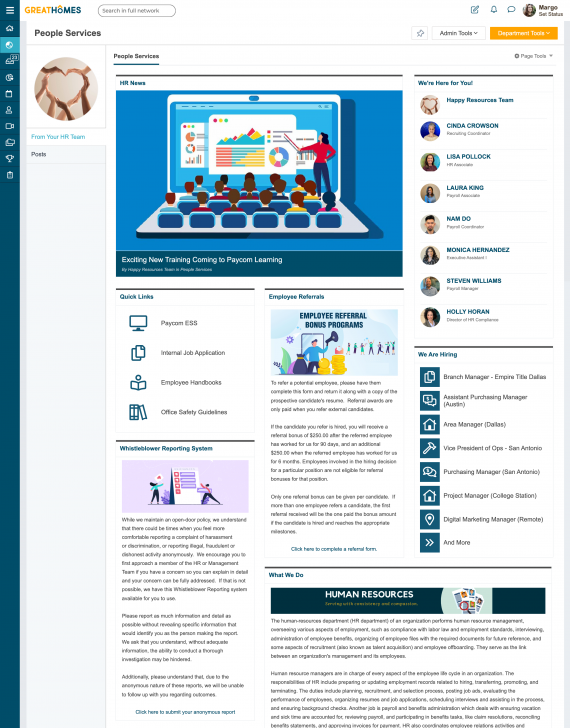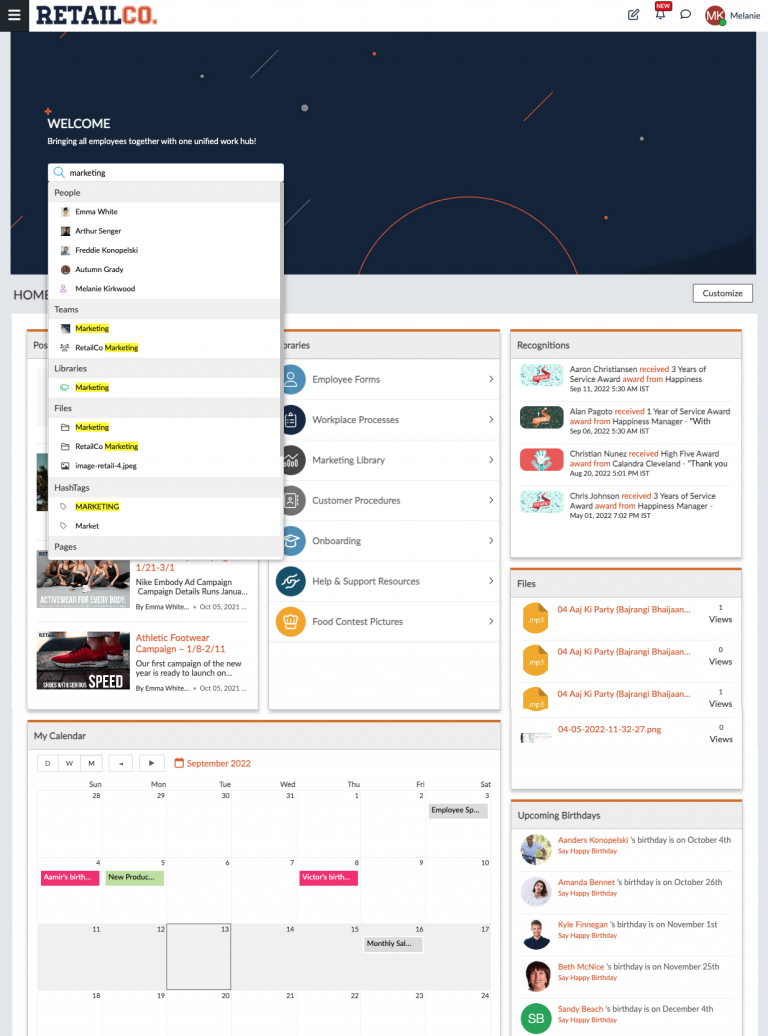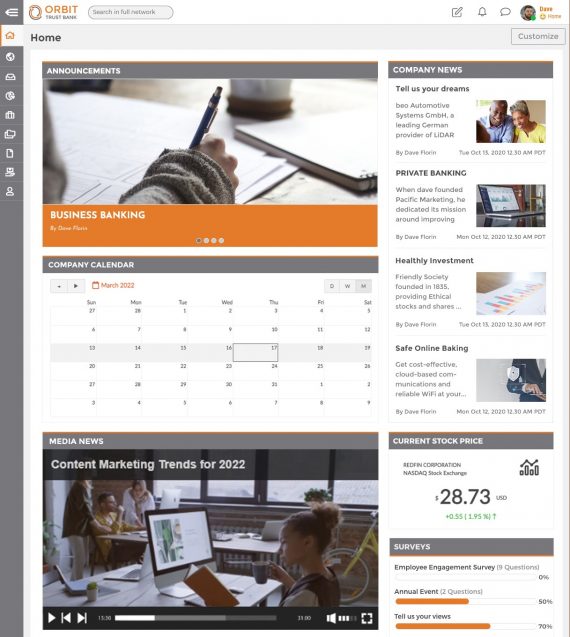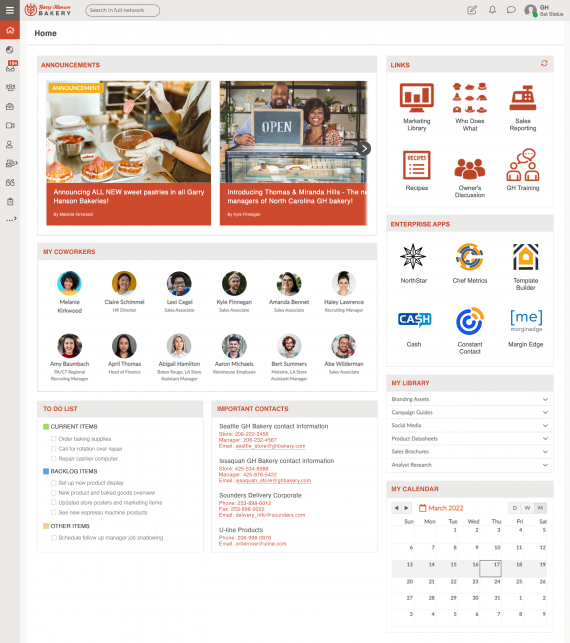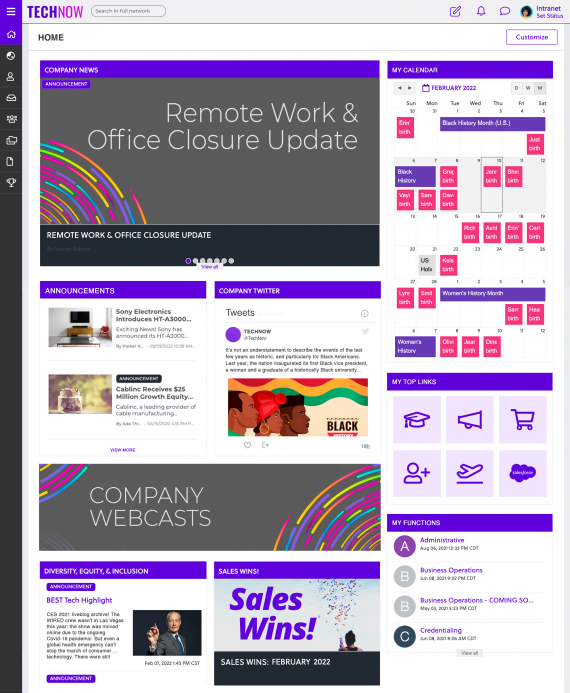This article is meant to serve as a guide for the best practices you need to know when building your intranet platform.
If you are considering making the switch to a modern intranet platform or want to learn how to build an intranet platform, then you are in the right place.
When built properly, a modern intranet can create a helpful, interactive, and centralized employee experience that transforms the way information flows throughout your workforce.
This article will serve as a comprehensive resource as your look to build your intranet platform. In this guide, we’ll tackle frequently asked questions such as:
How do we build an intranet? Which features should we be prioritizing? How do we make the intranet reflect our brand? How can we make sure that our employees are using it?
If you’re ready to make the switch, learn more about MangoApps modern intranet platform. Or, if you’re more interested in optimizing whatever solution you already have, check out our intranet content audit guide.
Jump to a topic:
- How to build an intranet
- Keeping your intranet relevant
- How to know if you need to build a new intranet
- The limitations of SharePoint
- Intranet samples
Best practices for building an intranet
A great intranet platform gives employees all the tools and resources they need to collaborate with their colleagues and be productive.
To accomplish that, you first have to select an intranet vendor and build out your intranet in a way that will set your employees up for future success.
Doing this can seem quite daunting, so we have laid out a detailed 10 step process that covers everything you need to know from building an intranet to getting people to use it.
Building an intranet in 10 easy steps:
1. Put a team together
The first step in building a modern intranet is to assemble a team to take on the task. This team should consist of several different departments from within your organization (this could include decision-makers, internal comms, HR, IT, etc.)
With a diverse range of ideas, jobs, and interests represented from the very beginning, you ensure your team accurately represents the needs of your company, ensuring that the intranet will have the internal support and advocacy it needs to invite, encourage, and persuade all employees to actively participate.
2. Establish goals and objectives
This is probably the most important of all intranet best practices. Once your team has been established, it’s time to determine the actual goals of your company’s intranet. By determining the objectives, you would like your intranet to accomplish, it can help keep everyone on the same page.
While every intranet platform is unique to its organization, common objectives you should consider include:
- Increasing internal company communication
- Improving team collaboration
- Managing organizational content and knowledge
- Developing company culture and engagement
3. Select a vendor
After you’ve created a general outline of intranet expectations, it’s time to choose a vendor.
Selecting the right vendor is one of the most important steps when it comes to building a company intranet. After all, your intranet vendor will ultimately determine not only your overall expenses, but also the capabilities, intuitiveness, security, and overall manageability of your entire platform.
Always choose a vendor you feel comfortable with, who not only offers the specific services you need but is always willing to support and work personally with you. For more guidance on this, see our list of questions to ask in an intranet demo.

Switch To A Modern Intranet
Learn about the benefits of switching to a modern intranet, and why it’s never too late to start building a better digital workplace for your employees.
Get your free eBook today!
4. Make the intranet your own
Once you have handpicked the intranet vendor that is best suited for your organization’s needs, the focus shifts to figuring out how to personalize and brand your platform. Determine the architecture and flow of the intranet and spend time thinking about what you want the design to look like.
A good vendor will make it easy to customize your intranet and alter colors, logos, fonts, and branding materials.
One of the best ways to get your intranet organized and off to a strong start is to personalize and brand your platform.
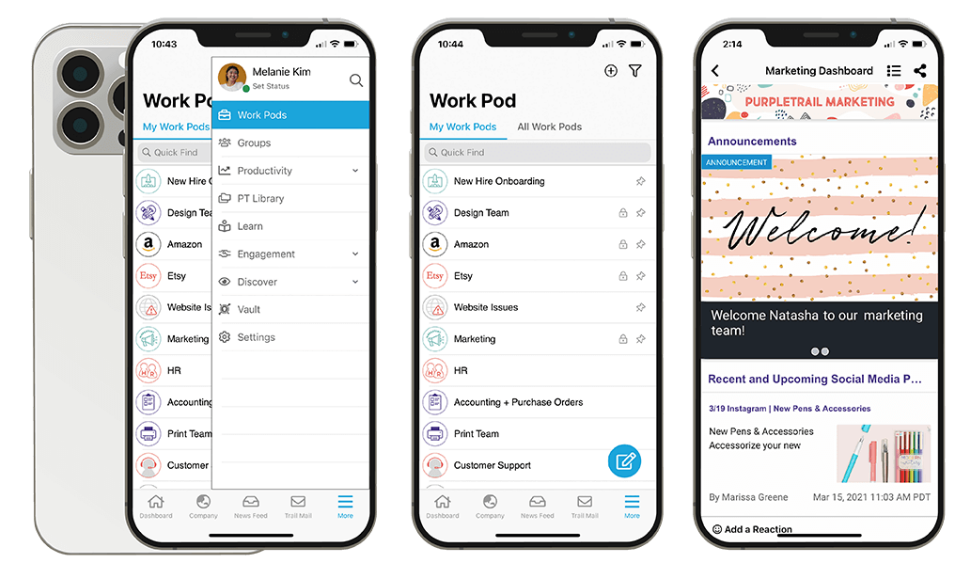
A distinctive and familiar intranet creates an inclusive environment right away where workers know they belong and are part of the team. Employees are also much more likely to engage with the platform if it feels like an extension of the company.
5. Organize your space
When building a modern intranet, it is important to think beforehand about how your organization plans to share, distribute, and access content.
While there are dozens of different ways to organize the details, most businesses arrange content by company, department, and group information. Here are the typical intranet organization best practices followed by our customers.
- Company information – typically includes content like company announcements, newsletters, holidays, and other announcements that are relevant at a company-wide level.
- Department news – consists of content that is relevant to the different departments within your organization. While companies typically have only one area for company content, businesses tend to have several department areas. Department information varies greatly from group to group depending on what kind of information they need.
- Group content – is the most specific and refers to different projects and teams within your organization. Groups can be determined by departments, locations, teams, or anything in-between. Groups also tend to involve more collaboration and back-and-forth communication than company or department areas do.
Our intranet design examples can help you visualize this and gather ideas.
6. Establish important features
A good intranet platform will include a wide range of useful out-of-the-box features designed to encompass a wide range and combination of needs. Before you begin creating or incorporating content, it’s important to edit, enable, disable, or customize the available modules and features for both your entire intranet platform and each individual department or group area.
You should also consider changing permissions for different employees and making different areas public/private. Read our article about the most important intranet features for more details.
7. Incorporate existing information
After you have completed the prior steps, now it is time to add information. You should add important company resources, information, employee handbooks, and anything else employees need regular or easy access to.
Don’t forget to add departmental information or information for specific projects/teams as well.
Uploading and maintaining all of this information can seem like an enormous undertaking. Our recommended best practice is to let the heads of departments maintain their department’s information. With a modern intranet platform, even the least tech-savvy managers can handle this task.
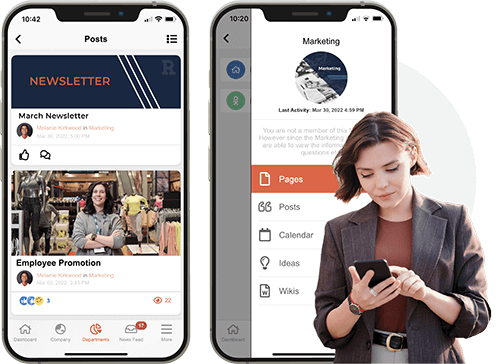
8. Host a launch party
An intranet launch party is a perfect opportunity to unveil your new platform and get your employees engaged with the platform. A successful launch party should incorporate advocates from various departments to encourage employees in every area and showcase several potential possibilities.
Employees need to know that your new modern intranet is an effective tool for everyone, not just one department or a handful of teams. The greater your scope of representation, the higher your overall participation will be.
Transferring to a new communication and collaboration style can sometimes be difficult, especially for workers who aren’t tech-savvy. A launch party helps inform and educate employees while also being a fun and inviting experience.
With everyone’s participation and contribution, an intranet will become much more than just an information repository and truly reach its full collaboration potential. Read our article on intranet engagement ideas for more on this topic.
9. Create new content that follows best practices
Finally, it’s time to create new content. Intranet content can be anything from new files to team events to just collaboration among employees. No matter how workers decided to connect with each other, sharing content is the most exciting part of an intranet.
Building a modern intranet allows you to facilitate this newly created content. As everyone works together, your intranet will become a relevant, useful, and long-term asset to the entire organization.
10. Regularly maintain your intranet
Over time your organization will naturally need to adapt and change as it grows in size, policy, mission, or mindset. As your company evolves it’s only natural for the intranet to adapt as well.
A good intranet enables administrators to easily add, remove, or edit platform features at any time. A regular review of intranet functions, features, and abilities will ensure your platform is always aligned with your company’s unique goals and style.
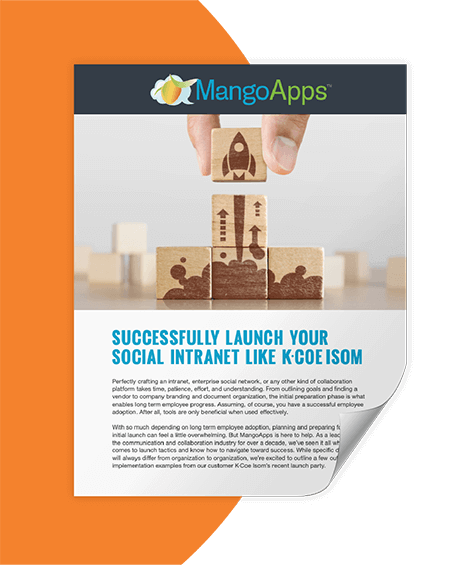
How To Launch Your Intranet
Perfectly crafting a modern intranet or any other kind of collaboration platform takes time, patience, effort, and understanding.
Learn what steps KCoe Isom took to properly launch their modern intranet platform and achieve great adoption numbers throughout the organization.
Best practices for keeping your intranet relevant
Once you have built your new company intranet, the focus shifts towards maintaining high levels of employee adoption. After all, your newly built intranet is only as useful as the content within it.
We have put together a few best practices that can help your organization guarantee a relevant, useful, and engaging intranet platform.
Make your intranet mobile-friendly
No matter your organization’s line of work, it’s pretty safe to assume that at least some work happens on the go. From frontline employees to traveling C-suite executives, modern work happens anywhere and everywhere.
Enabling easy and reliable intranet access to workers away from the office ensures that employees never go without important information. The simplest way to do this is by making ‘mobile intranet‘ a pre-qualifying requirement during your organization’s search for a platform.
Embrace your brand
Personalizing and branding your intranet will help employees relate to it and encourage participation. In doing this, you can help employees get more engaged with the platform as they will often think of it as an extension of their company.
Incorporate integrations
It’s important to maintain a centralized workspace by integrating necessary apps into your intranet. When crafting your intranet platform, make sure that it can incorporate the integrations and tools that your employees most frequently use.
By acting as a ‘one-stop shop’, you can encourage employees to frequently visit your intranet for anything they might need to do their jobs.
Train your employees
Educate your employees on how to best use the intranet. While this may take some time upfront, a thorough and detailed training session can help employees become more comfortable with the intranet.
It is also important to release training courses on any new modules/features your intranet offers as they are released.
Track employee interests
A good intranet will provide administrators with all of the tracking tools they need to see employee interest, gauge current needs, and establish future success.
With monitoring and tracking tools embedded into the program, employers can easily see which pages are most popular, where workers spend most of their time, and what areas might need a little improvement.
Conduct surveys
Tracking tools allow administrators to establish quizzes, surveys, and other methods, to monitor feedback and see employee opinions firsthand. Successful surveys should be deployed over a set timeline and should include clear, inclusive, and open-ended questions.
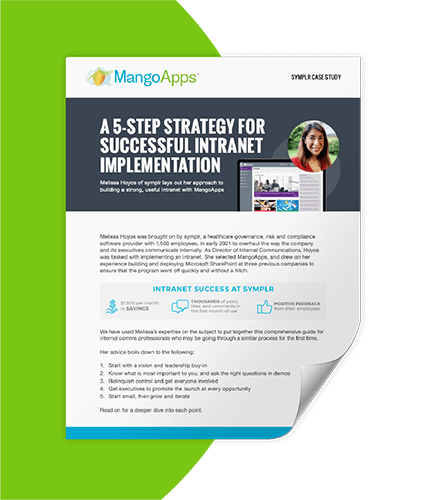
How To Build A Useful Intranet
- Start with a vision and buy-in from leadership
- Ask the right questions during demos
- Relinquish control and get everyone involved
- Get executives to promote the intranet at every opportunity
- Start small, grow, and iterate
How to know if you need to build a new intranet
It can be tricky to identify when it’s time to move on from your current intranet. Whether you are not wanting to make the commitment to switch, or you are not fully cognizant of the limitations of your current intranet’s features.
Most people often fall into one of these three buckets:
Bucket 1:
You’ve learned to cope with your clunky, outdated, and difficult-to-navigate intranet that hinders the productivity of your employees.
Bucket 2:
You are unaware of the limitations of your existing intranet platform.
Bucket 3:
Your modern intranet platform enables strong collaboration and allows your employees to be as productive as possible.
As we see a shift in digital transformation towards modern intranet best practices, we recognize that an alarming amount of people fall into Buckets 1 & 2.
If you are unsure whether your company needs a new intranet platform, take a look at the graphic below to get a better understanding of the current limitations of your existing intranet.
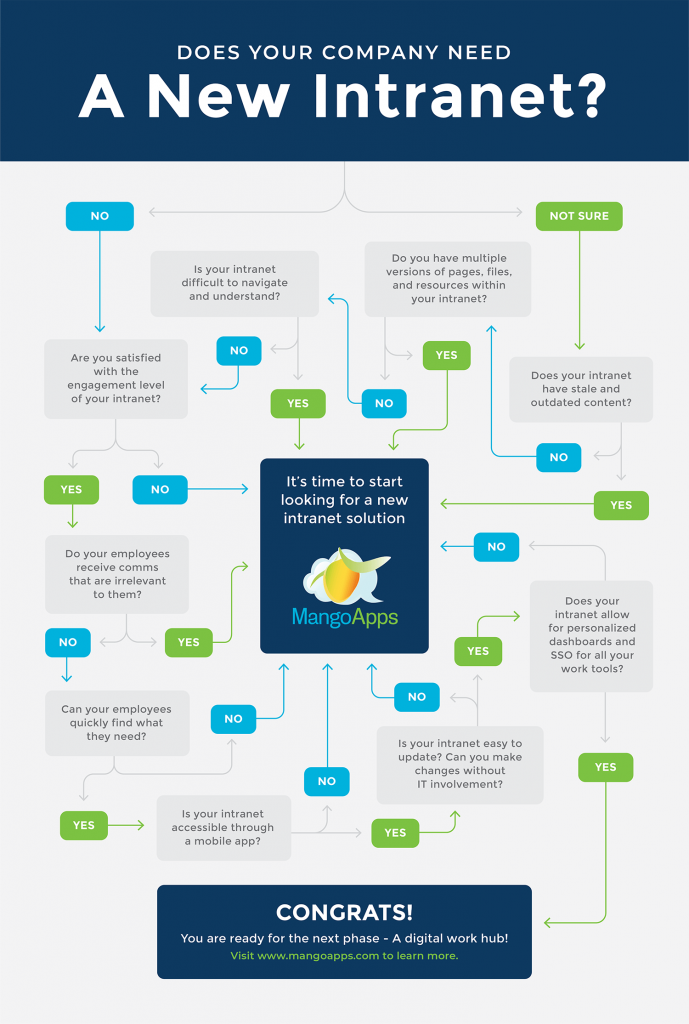
Intranet samples
Lastly, we recognize that intranets come in all shapes and sizes. Choosing what style works best for your company can be daunting. How do you know what information to include, what features will engage your employees, and what intranet solution will be easy to implement and maintain?
We have collected various intranet design examples to help inspire your company’s intranet endeavor and demonstrate some of our customers’ intranet best practices.
Resources
For further reading, take a look at our case studies with TeamHealth and Great Harvest Bread.


